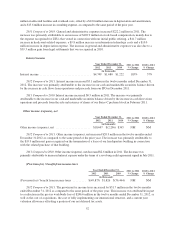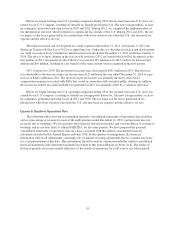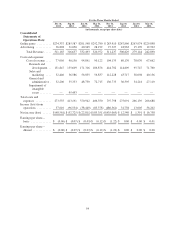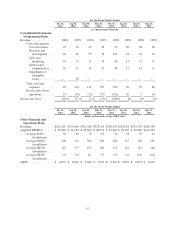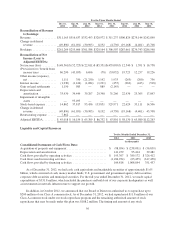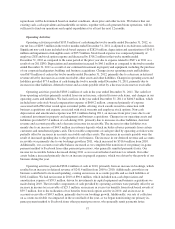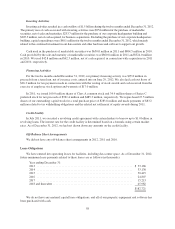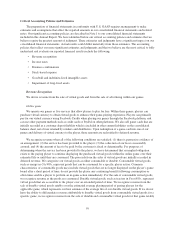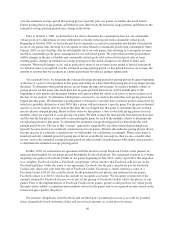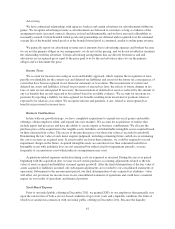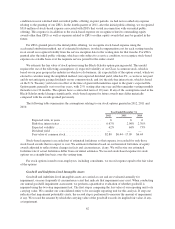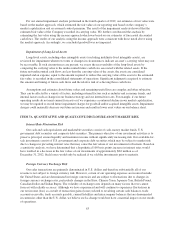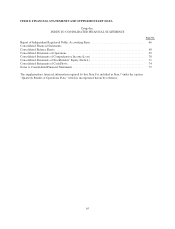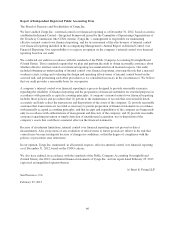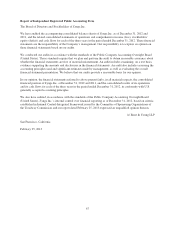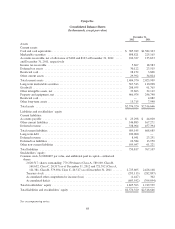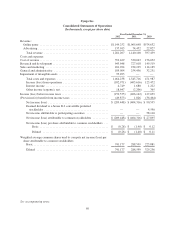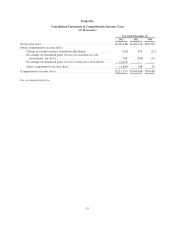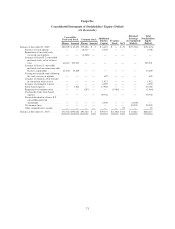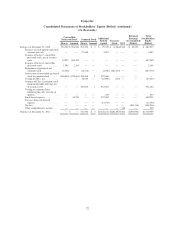Zynga 2012 Annual Report Download - page 70
Download and view the complete annual report
Please find page 70 of the 2012 Zynga annual report below. You can navigate through the pages in the report by either clicking on the pages listed below, or by using the keyword search tool below to find specific information within the annual report.
condition was not satisfied until our initial public offering, in prior periods, we had not recorded any expense
relating to the granting of our ZSUs. In the fourth quarter of 2011, after the initial public offering, we recognized
$510 million of stock-based expense associated with ZSUs that vested in connection with our initial public
offering. This expense is in addition to the stock-based expense we recognize related to outstanding equity
awards other than ZSUs as well as expenses related to ZSUs or other equity awards that may be granted in the
future.
For ZSUs granted prior to the initial public offering, we recognize stock-based expense using the
accelerated attribution method, net of estimated forfeitures, in which compensation cost for each vesting tranche
in an award is recognized ratably from the service inception date to the vesting date for that tranche. For ZSUs
granted after the initial public offering, which are only subject to a service condition, we recognize stock-based
expense on a ratable basis over the requisite service period for the entire award.
We estimate the fair value of stock options using the Black-Scholes option-pricing model. This model
requires the use of the following assumptions: (i) expected volatility of our Class A common stock, which is
based on our peer group in the industry in which we do business; (ii) expected life of the option award, which we
elected to calculate using the simplified method; (iii) expected dividend yield, which is 0%, as we have not paid
and do not anticipate paying dividends on our common stock; and (iv) the risk-free interest rate, which is based
on the U.S. Treasury yield curve in effect at the time of grant with maturities equal to the grant’s expected life.
Option grants generally vest over four years, with 25% vesting after one year and the remainder vesting monthly
thereafter over 36 months. The options have a contractual term of 10 years. If any of the assumptions used in the
Black-Scholes model changes significantly, stock-based expense for future awards may differ materially
compared with the awards granted previously.
The following table summarizes the assumptions relating to our stock options granted in 2012, 2011 and
2010:
Year Ended December 31,
2012 2011 2010
Expected term, in years ........................... 6 6 6
Risk-free interest rates ............................ 0.67% 2.04% 2.70%
Expected volatility ............................... 62% 64% 73%
Dividend yield .................................. — — —
Fair value of common stock ........................ $2.80 $6.44 - 17.09 $6.44
Stock-based expense is recorded net of estimated forfeitures so that expense is recorded for only those
stock-based awards that we expect to vest. We estimate forfeitures based on our historical forfeiture of equity
awards adjusted to reflect future changes in facts and circumstances, if any. We will revise our estimated
forfeiture rate if actual forfeitures differ from our initial estimates. We record stock-based expense for stock
options on a straight-line basis over the vesting term.
For stock options issued to non-employees, including consultants, we record expense equal to the fair value
of the options
Goodwill and Indefinite-Lived Intangible Assets
Goodwill and indefinite-lived intangible assets are carried at cost and are evaluated annually for
impairment, or more frequently if circumstances exist that indicate that impairment may exist. When conducting
our annual goodwill impairment assessment, we perform a quantitative evaluation of whether goodwill is
impaired using the two-step impairment test. The first step is comparing the fair value of our reporting unit to its
carrying value. We consider our consolidated entity to be our single reporting unit for this analysis. If step one
indicates that impairment potentially exists, the second step is performed to measure the amount of impairment,
if any. We record the amount by which the carrying value of the goodwill exceeds its implied fair value, if any,
as impairment.
62


